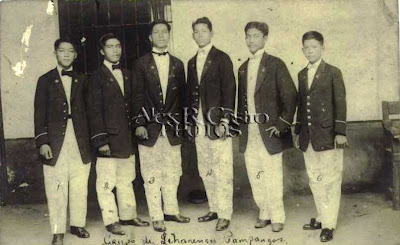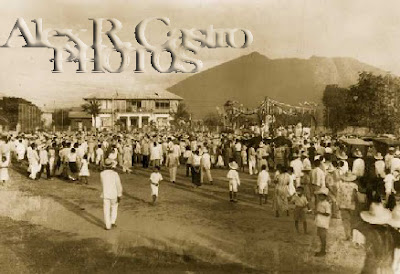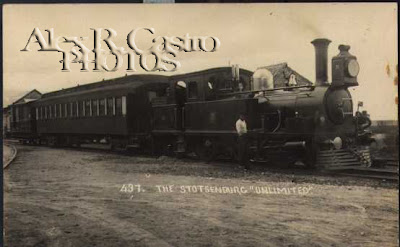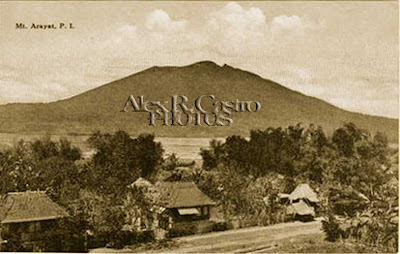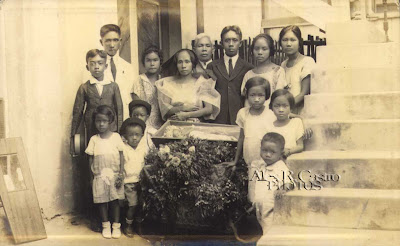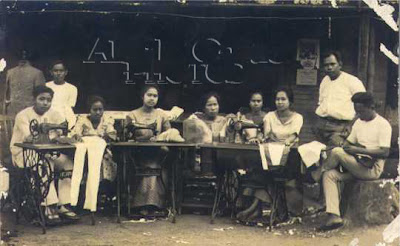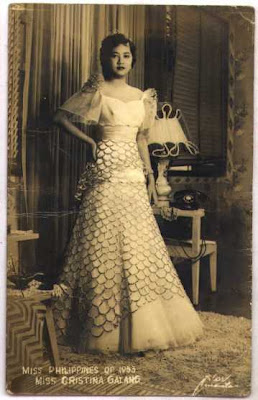 FAIREST AT THE FAIR. Maria Cristina Galang of Tarlac, Tarlac shows her winning form in this official portrait as Miss Philippines 1953 at the 1st Philippine International Fair.
FAIREST AT THE FAIR. Maria Cristina Galang of Tarlac, Tarlac shows her winning form in this official portrait as Miss Philippines 1953 at the 1st Philippine International Fair.From the 1930s to the 1960s, the world was caught up in the excitement of international fairs and expositions. The successful hosting of New York’s World Fair 1939-1940 inspired other countries to put up their own, as showcases of progress, goodwill and international friendship. In 1952, the Philippines joined the bandwagon, and not even the brewing war in Korea could dampen the country’s spirit as it launched the first ever Philippine International Fair. held in Manilaf from 1 feb.-30 April 1953. As in the Manila Carnivals of old, Luneta was chosen as the venue of the Fair, complete with a man-made lagoon, pavilions and booths. It was hailed in media as the "biggest event of its kind ever to be held in this country--inspiring in magnitude and significance...promising unsurpassed entertainment for old and young alike!". So important was the Fair that a commemorative stamp was even issued to mark the occasion.
The Philippine International Fair’s most attractive highlight was the coronation of Miss Philippines 1953. Rising movie stars, glamorous high society girls and beautiful delegates from chartered cities and the provinces rushed to join the competition. The early favorites were Alice Fuentes of Baguio, Antonia Tan and Violeta Villamor. A budding Mindanao was represented by a well-known socialite, Gilda Walstrom, who was romantically linked to young Ferdinand Marcos before he met his Imelda (incidentally, Imelda Romualdez was present at the pageant as 1953 Miss Manila nominee). But it was a fair convent-bred Kapampangan beauty from Tarlac, Tarlac who walked away with the Miss Philippines 1953 title, Maria Cristina Galang.
A daughter of a former governor of Tarlac, Alejandro Galang, Cristina’s victory was significant, for she was crowned by no less than the visiting 1st Miss Universe of 1952, Armi Kuusela of Finland (Armi later married rich Filipino businessman Virgilio Hilario after a much-publicized whirlwind courtship). Armi was assisted by the 1952 queen, Teresita Sanchez. Cristina’s escort was her kabalen (provincemate), the young Ninoy Aquino. The pageant committee originally wanted Cristina to join the 1953 Miss Universe in Long Beach, California, but this did not push through. Instead, a namesake, Cristina Pacheco was sent to the international competition.
Even then, Tarlac showed its gratitude to Cristina by throwing a lavish Despedida Dance at the Tarlac Trade School Court in her hometown on 5 September 1953. Tarlac’s most prominent citizens, headed by Governor and Mrs. Antonio E. Lopez and Mayor Hipolito Castañeda graced the occasion. A park was also fittingly named after her, the Maria Cristina Park, located near the provincial capitol.
Cristina acted as the official welcomer of the 1st Philippine International Fair, meeting important dignitaries, foreign visitors and lending her beautiful presence in several social events. After her duties though, Cristina pursued her academic ambitions, going to Georgian University in New Jersey for a liberal arts course and then to Fordham University in New York for her graduate studies in Sociology. In New York, she met Dr. Jose Caedo, who was then training at the Cancer Memorial Hospital. The two came back to the Philippines to get married but packed their bags again for the U.S. where Dr. Caedo finished his diplomate. Eventually, they came home a second time as Dr. Caedo was appointed Director of the G.S.I.S. Hospital.
Back home, Cristina became a university professor and took on a glamorous job as a bridal consultant. She gave these all up to devote more time to her 3 children, 2 boys and a girl, at the same time engaging in socio-civic activities way into the 1980s. Cristina thus joins an alluring bevy of Tarlac belles who have claimed the national spotlight with their beauty, brains and breeding, a list that includes Luz Besa, ( Miss Tarlac 1927), Isolina Palma (Miss Tarlac 1926) and Margarita “Tingting” de los Reyes-Cojuangco, voted as one of the 50 most beautiful women in the world by Harper’s Magazine.
(30 November 2002)
The Philippine International Fair’s most attractive highlight was the coronation of Miss Philippines 1953. Rising movie stars, glamorous high society girls and beautiful delegates from chartered cities and the provinces rushed to join the competition. The early favorites were Alice Fuentes of Baguio, Antonia Tan and Violeta Villamor. A budding Mindanao was represented by a well-known socialite, Gilda Walstrom, who was romantically linked to young Ferdinand Marcos before he met his Imelda (incidentally, Imelda Romualdez was present at the pageant as 1953 Miss Manila nominee). But it was a fair convent-bred Kapampangan beauty from Tarlac, Tarlac who walked away with the Miss Philippines 1953 title, Maria Cristina Galang.
A daughter of a former governor of Tarlac, Alejandro Galang, Cristina’s victory was significant, for she was crowned by no less than the visiting 1st Miss Universe of 1952, Armi Kuusela of Finland (Armi later married rich Filipino businessman Virgilio Hilario after a much-publicized whirlwind courtship). Armi was assisted by the 1952 queen, Teresita Sanchez. Cristina’s escort was her kabalen (provincemate), the young Ninoy Aquino. The pageant committee originally wanted Cristina to join the 1953 Miss Universe in Long Beach, California, but this did not push through. Instead, a namesake, Cristina Pacheco was sent to the international competition.
Even then, Tarlac showed its gratitude to Cristina by throwing a lavish Despedida Dance at the Tarlac Trade School Court in her hometown on 5 September 1953. Tarlac’s most prominent citizens, headed by Governor and Mrs. Antonio E. Lopez and Mayor Hipolito Castañeda graced the occasion. A park was also fittingly named after her, the Maria Cristina Park, located near the provincial capitol.
Cristina acted as the official welcomer of the 1st Philippine International Fair, meeting important dignitaries, foreign visitors and lending her beautiful presence in several social events. After her duties though, Cristina pursued her academic ambitions, going to Georgian University in New Jersey for a liberal arts course and then to Fordham University in New York for her graduate studies in Sociology. In New York, she met Dr. Jose Caedo, who was then training at the Cancer Memorial Hospital. The two came back to the Philippines to get married but packed their bags again for the U.S. where Dr. Caedo finished his diplomate. Eventually, they came home a second time as Dr. Caedo was appointed Director of the G.S.I.S. Hospital.
Back home, Cristina became a university professor and took on a glamorous job as a bridal consultant. She gave these all up to devote more time to her 3 children, 2 boys and a girl, at the same time engaging in socio-civic activities way into the 1980s. Cristina thus joins an alluring bevy of Tarlac belles who have claimed the national spotlight with their beauty, brains and breeding, a list that includes Luz Besa, ( Miss Tarlac 1927), Isolina Palma (Miss Tarlac 1926) and Margarita “Tingting” de los Reyes-Cojuangco, voted as one of the 50 most beautiful women in the world by Harper’s Magazine.
(30 November 2002)








